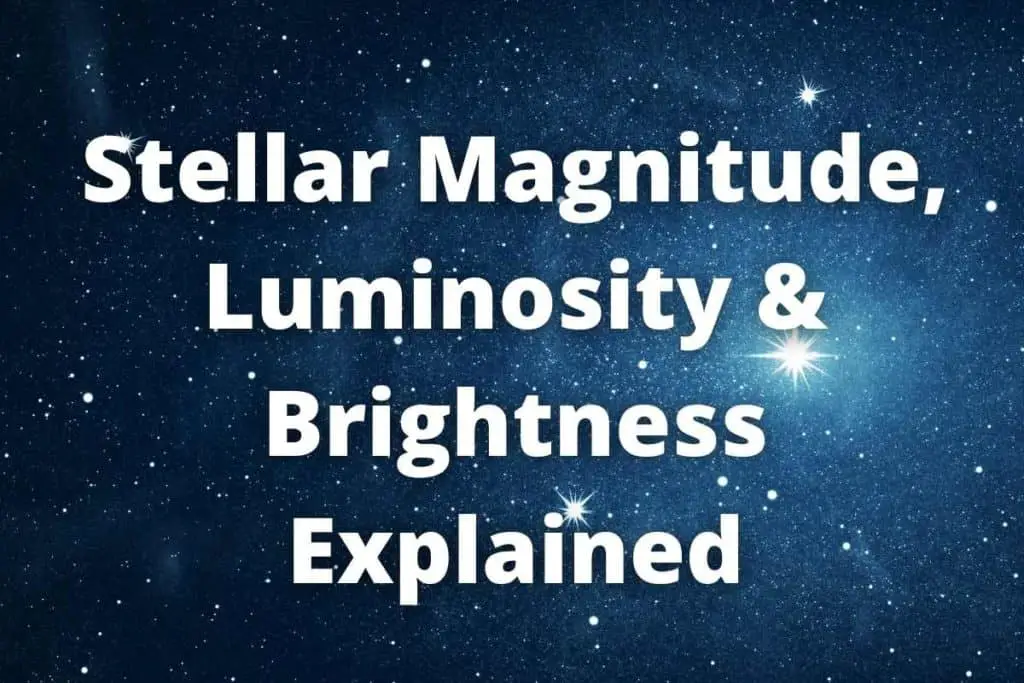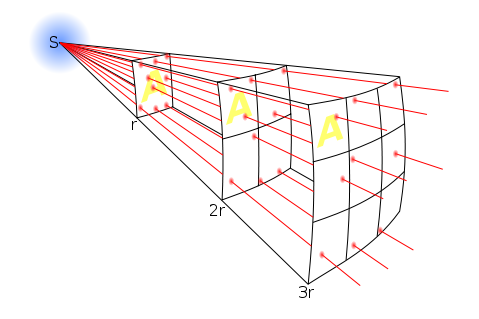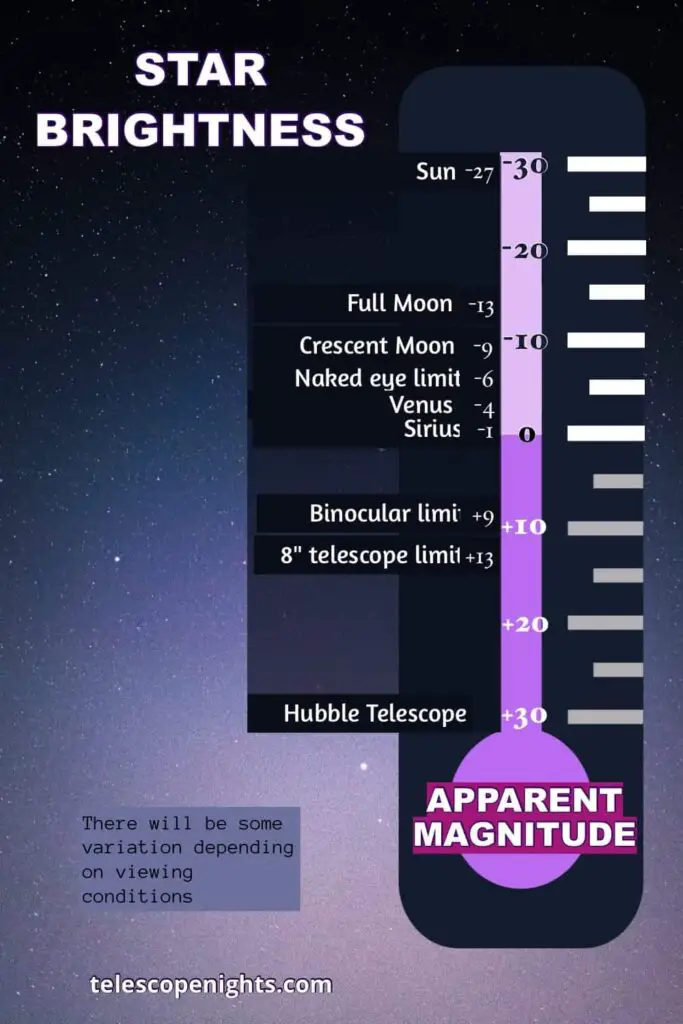How does stellar magnitude relate to your night sky viewing experience? As a newbie, I found terms like this a little confusing. So here I explore star magnitude along with brightness and luminosity for newbie backyard astronomers.

Why this is important: When looking to buy a telescope or astronomy binoculars, you might come across the term ‘limiting magnitude’. This might be written as ‘stellar magnitude‘ — stellar, meaning star. It’s worth knowing what it refers to and what it means for your sky viewing experience.
Star magnitude explained
Let’s start with apparent magnitude vs absolute magnitude: In astronomy, apparent magnitude represents a star’s brightness viewed from Earth; absolute magnitude indicates a star’s brightness viewed from a standard distance (32.6 light years); and stellar magnitude is another way of expressing apparent magnitude.
Naturally, the magnitude of interest to backyard astronomers is the apparent (vs absolute) magnitude. So in general, ‘magnitude’ means apparent magnitude and it depends on three measures: 1) its distance from Earth, 2) the amount of light it emits, and 3) interstellar dust in the line of sight.
What magnitude star is visible through my telescope? One way of knowing the magnitude you can see with your telescope is to look up the limiting magnitude in the telescope’s specifications.
Otherwise, as a guide, you can see stars down to 9th magnitude with binoculars and small telescopes and down to 13th with an 8″ aperture. See my star brightness chart below and following this, a table of aperture size against faintest magnitude.
Telescope Limiting Magnitude Table
The following table gives us a rough guide of the star magnitude telescope aperture relationship based on Harrington’s calculations given in Star Ware – The Amateur Astronomer’s Guide to Choosing, Buying, and Using Telescopes and Accessories, available at Amazon–see it here (affiliate link). Note: What you experience will vary with skill and the sky conditions.
Telescope aperture and star magnitude limit
| Aperture Inches | Aperture mm | Faintest Magnitude |
|---|---|---|
| 2 | 51 | 10.3 |
| 3 | 76 | 11.2 |
| 4 | 102 | 11.8 |
| 6 | 152 | 12.7 |
| 8 | 203 | 13.3 |
| 10 | 254 | 13.8 |
| 12.5 | 318 | 14.3 |
| 14 | 356 | 14.5 |
| 16 | 406 | 14.8 |
| 18 | 457 | 15.1 |
| 20 | 508 | 15.3 |
| 24 | 610 | 15.7 |
| 30 | 762 | 16.2 |
luminosity vs brightness
Luminosity represents the energy emitted by a star from its surface, whereas a star’s brightness, expressed as apparent magnitude, is its visibility from a viewing perspective, which, for us, is Earth.
Star brightness is what matters to us backyard astronomers as it refers to a star’s visibility from Earth. Luminosity relates to the star’s surface only but does form one part of the equation of star brightness, or how visible the star is from Earth (distance is another). Note: The observed star’s brightness never equals its luminosity (with one hypothetical exception that I explain later).
Luminosity: The word ‘luminosity’ means the state of reflecting bright light (Source: Cambridge Dictionary). In astronomy, it refers to the energy emitted from a star’s surface, often written per unit of time.
Luminosity vs absolute magnitude
Luminosity corresponds to absolute magnitude but in opposing directions. The Hertzspring-Russell diagram below shows this relationship best. See how the positive high luminosity (>10000 Suns) of the red giants Betelgeuse and Antares corresponds to negative absolute magnitudes.
When querying star brightness against luminosity and absolute magnitude, you’re probably wondering how apparent magnitude fits into the picture. As the best astronomy books tell us, this has to do with distance…
Star brightness and distance
Star brightness expressed as apparent magnitude is the brightness of the star from a viewing perspective. In this case, the distance will vary. As a star’s light emitted at its surface travels the distance to where it’s viewed, the light spreads out and its visual brightness diminishes. With absolute magnitude, the observing distance is confined to 10 parsecs (aka 32.6 light years).

Here’s the hypothetical exception I mentioned earlier…if a star’s distance from Earth or any other viewing perspective is 32.6 light-years, then its star brightness (as apparent magnitude) would equal its absolute magnitude and indicate its luminosity. The apparent magnitude of the star from a distance of 32.6 light-years equals its absolute magnitude. Or, think of it like this…These two measures: apparent magnitude and absolute magnitude, are the same in a situation where the star’s distance from the viewing perspective is 32.6 light years.
The beauty of absolute magnitude is that it standardizes the observing distance so you can compare stars according to their actual or absolute brightness rather than their apparent one.
Why do stars differ in brightness?
Stars differ in brightness to us because of their luminosity, distance from Earth, and interstellar dust in the line of sight.
Luminosity: We know that stars emit energy and that this luminosity varies among them. Some are more luminous than others because they’re larger or hotter than others. Stars with the same luminosity will differ in brightness to us because of their distance from Earth.
The human eye perceives objects as brighter when they are closer to us because there is more light available for our eyes. Note that even with its proximity to us, Proxima Centauri is not as bright as other stars in the list. It’s a small red dwarf and so its luminosity is low relative to the others.
Distance: Stars that are farther away will appear dimmer than those that are not so far away (with equivalent luminosity).
Planet apparent magnitude: The planets are close in distance to Earth relative to the stars, apart from the Sun of course. And that’s the reason their apparent magnitude is higher than many of the stars in the sky. (You’ll find the mean planet magnitudes from Earth included in the list below.)
So luminosity and distance from Earth account for a star’s brightness in our sky. But let’s not forget that interstellar dust in the line of sight can take away some of that brightness.
It’s also important to note that the brightness of a star changes as it ages, from when it’s born to when it’s extinguished. I cover this further in my article on star types.
Star brightness scale
Brightness of stars viewed from Earth is relevant to us backyard astronomers. A scale of apparent magnitude helps us to know what stars are visible to us.
This scale stems from Hipparchus, a Greek astronomer, who 2100 years ago came up with a scale to classify stars by brightness. The astronomer, Sir Norman Robert Pogson, then tweaked it in 1856 to formalise today’s system.
In today’s magnitude scale charts, you’ll find stars and planets on the scale that ranges from –30 (bright end) to +30 (faint end). Our star, the Sun has a magnitude of –26.7, our Moon when full a magnitude of –12.6, and Sirius a magnitude of –1.4.
The following chart shows a list of stars with an apparent magnitude you can see in the night sky with astronomy binoculars or a small telescope (–1 and up to +9 roughly).
Star magnitude brightness relationship
Maybe you’d like to compare what is visible to you in the night sky and see how they vary in brightness. This can make star hopping a little more fun and something the family can enjoy when outdoors.
The accompanying chart can help with this. It looks at star magnitude and how it varies with brightness. It is logarithmic and each change in magnitude in the scale indicates an average change in brightness by a factor of 2.512.
For instance, with change in magnitude of 5 (first column), a 1st magnitude star is 100x (2.5122x; second and third column) the brightness of a 6th, which is, by the way, the limit of an unaided human eye.
Real-world examples: Our Sun’s magnitude is –26.7 and Sirius is –1.4 (change in magnitude ~ 25), so our Sun is roughly 10.012 billion times brighter (2.51225x) than Sirius.
The Betelgeuse star magnitude is +0.5 compared to Sirius at –1.4 (change in magnitude ~2), so Sirius is 6.3x (2.5122) brighter than Betelgeuse.
Summing it
This article is not exhaustive on all things related to star magnitude but it will give you some concept of this term about the stars visible through your telescope and hopefully spur your interest in learning more.
FAQs
Info sources
Nasa: Star Types; Swin Edu: Absolute vs apparent; Jim Tubbs amatuer astronomer: on luminosity
- Dickinson, T. 2019. NightWatch: A Practical Guide to Viewing the Universe. (affiliate link) Firefly Books.




